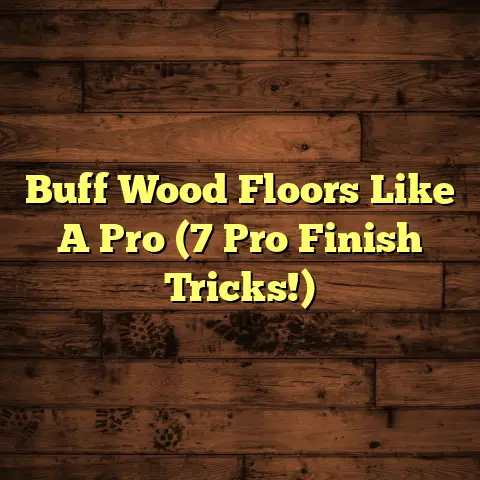Best Flooring For Uneven Concrete? (5 Subfloor Tips)
I’m a flooring contractor, and I’ve seen it all when it comes to floors.
From brand-new builds to homes that have seen a few generations, one thing is consistent: everyone wants beautiful, functional flooring.
But what happens when you’re faced with a less-than-perfect concrete subfloor?
Uneven concrete can throw a wrench into your flooring dreams.
It can affect not only the visual appeal of a space but also its safety and functionality.
Trust me, I’ve seen folks trip over uneven floors more times than I can count!
That’s why it’s crucial to address this issue head-on.
Trends in interior design might come and go, but quality and durability are everlasting.
So, let’s dive into the world of flooring and figure out the best options for tackling uneven concrete.
I’ll share some practical tips and insights I’ve learned over the years.
Ready? Let’s get started!
1. Understanding Uneven Concrete Floors
Okay, first things first, let’s talk about why your concrete floor might be looking a bit like a roller coaster.
1.1 Common Causes of Uneven Concrete Floors
There are several reasons why concrete floors become uneven.
Think of it like this: concrete is tough, but it’s not invincible.
Settling: This is a big one.
Over time, the ground beneath your house can shift and settle.
This can cause cracks and unevenness in the concrete slab.
I’ve seen this happen a lot in older homes, especially in areas with unstable soil.Water Damage: Water is a concrete’s worst enemy.
If water seeps in, it can erode the soil underneath, leading to sinking and unevenness.
I once worked on a house where a leaky pipe had caused significant damage, resulting in a severely uneven floor.Poor Installation: Sometimes, the issue is simply a bad pour.
If the concrete wasn’t properly leveled during the initial installation, you’re going to have problems down the line.
I’ve seen cases where contractors cut corners, and it always comes back to bite the homeowner.Tree Roots: Believe it or not, tree roots can wreak havoc on concrete foundations.
As they grow, they can exert pressure on the slab, causing it to crack and shift.
Think of Mrs. Peterson, a client I worked with last year.
Her home, built in the 1950s, had significant settling issues.
The living room floor had a noticeable slope, and you could feel it when you walked across the room.
We ended up having to use a self- leveling compound to correct the issue before installing new flooring.
1.2 Identifying Unevenness
So, how do you know if your floor
is uneven?
Here are a few simple
methods:
The Level Test: Grab a good ol’ level (a 4-foot level is ideal) and place it on the floor in various spots.
If the bubble isn’t perfectly centered, you’ve got an uneven spot.The Rolling Test: Take a marble or a small ball and see if it rolls on its own.
If it does, that’s a pretty good sign your floor isn’t level.The Water Test: This one’s a bit messier, but effective.
Pour a small amount of water on the floor.
If it pools in certain areas, those are low spots.The Hose Method: For larger areas, a water-filled hose can be surprisingly accurate.
Attach a clear tube to each end of a garden hose.
Fill the hose with water, ensuring no air bubbles are present.
Hold the ends of the tube side by side; the water level should be the same.
Move one end to different points in the room and compare the water levels to identify high and low spots.
The degree of unevenness matters.
A slight dip might be manageable with the right flooring choice, but significant slopes require more serious intervention.
For example, a difference of more than 1/4 inch over a 10-foot span is generally considered significant and might require leveling.
According to the American Concrete Institute (ACI), tolerances for floor flatness and levelness are specified in ACI 302.1R, “Guide for Concrete Floor and Slab Construction.”
Understanding the extent of the problem is the first step toward finding the right solution.
2. Best Flooring Options for Uneven Concrete
Alright, now for the fun part!
Let’s talk about the best flooring
options for those less-than-perfect
concrete surfaces.
2.1 Vinyl Flooring
Vinyl flooring is a fantastic option for uneven concrete.
Why? Because it’s flexible, durable, and relatively easy to install.
Flexibility: Vinyl can conform to minor imperfections in the subfloor without telegraphing them to the surface.
This means you won’t see every little bump and dip.-
Ease of Installation: Many vinyl products come in planks or tiles with click-lock systems, making them DIY-friendly.
-
Moisture Resistance: Vinyl is inherently water-resistant, making it a great choice for basements or areas prone to moisture.
There are different types of vinyl flooring to consider:
Sheet Vinyl: This comes in large rolls and offers a seamless look.
It’s a good option for bathrooms or kitchens where you want to minimize seams.Luxury Vinyl Plank (LVP): LVP mimics the look of hardwood and is incredibly durable.
It’s a popular choice for living rooms and bedrooms.Luxury Vinyl Tile (LVT): LVT replicates the look of stone or ceramic tile.
It’s a great option for kitchens and bathrooms.
I remember installing LVP in a basement that had some minor unevenness.
The homeowner was thrilled with how the flooring looked and how it completely transformed the space.
It’s a cost-effective and practical solution.
2.2 Laminate Flooring
Laminate is another popular choice for uneven concrete, mainly because it’s cost-effective and can look great.
-
Aesthetic Appeal: Laminate comes in a wide variety of styles and colors, mimicking the look of hardwood, tile, and stone.
-
Cost-Effectiveness: Laminate is generally more affordable than hardwood or tile, making it a budget-friendly option.
Installation: Laminate is typically installed as a floating floor, which means it’s not directly adhered to the subfloor.
This allows it to bridge minor imperfections.
However, laminate isn’t as water- resistant as vinyl, so it’s not the best choice for areas prone to moisture.
Also, it’s important to use a good quality underlayment to help cushion the floor and minimize any unevenness.
I’ve used laminate in many projects, and it’s always a hit with clients looking for an affordable and stylish option.
2.3 Engineered Hardwood
Engineered hardwood is a fantastic choice if you want the look of real wood but need something more stable than solid hardwood.
-
Timeless Beauty: Engineered hardwood offers the classic look and feel of real wood, adding warmth and elegance to any space.
Stability: Engineered hardwood is constructed with multiple layers of wood, making it more resistant to warping and cupping than solid hardwood.
This stability makes it a good option for uneven concrete.-
Versatility: It can be installed in a variety of ways, including floating, gluing, or nailing, depending on the specific product and the condition of the subfloor.
I often recommend engineered hardwood for clients who want the look of hardwood but have concerns about moisture or unevenness.
It’s a great compromise between beauty and practicality.
2.4 Carpet
Don’t underestimate the power of
carpet!
It’s a great way to hide
imperfections and add warmth and
comfort to a room.
-
Hides Imperfections: Carpet can easily conceal minor unevenness in the subfloor.
-
Warmth and Comfort: Carpet adds a layer of insulation, making your floors warmer and more comfortable underfoot.
-
Variety: Carpet comes in a wide range of colors, textures, and styles, allowing you to create a cozy and inviting space.
The key to success with carpet on uneven concrete is to use a high- quality underlayment.
A thicker, more dense underlayment will provide more cushioning and help to minimize any unevenness.
I’ve seen carpet completely transform rooms with less-than-perfect floors.
It’s a simple and effective way to create a comfortable and visually appealing space.
2.5 Tile
Tile is a classic choice that offers durability and versatility.
However, it’s also one of the most challenging options for uneven concrete.
-
Durability: Tile is incredibly durable and can withstand heavy foot traffic.
-
Versatility: Tile comes in a wide range of styles, colors, and sizes, allowing you to create a unique and personalized look.
-
Water Resistance: Tile is highly water-resistant, making it a great choice for bathrooms and kitchens.
The key to installing tile on uneven concrete is to properly prepare the subfloor.
This may involve using a self- leveling compound to create a smooth, even surface.
Without proper preparation, the tile can crack or become uneven over time.
I always tell my clients that tile is an investment.
It requires careful planning and execution, but the results can be stunning.
3. Subfloor Preparation Tips
Okay, now let’s get into the nitty- gritty of subfloor preparation.
This is where the rubber meets the road, folks!
Properly preparing your subfloor is essential for a successful flooring installation.
3.1 Evaluate and Repair the Concrete Surface
Before you even think about installing new flooring, you need to thoroughly evaluate the concrete surface.
Inspect for Cracks: Look for any cracks in the concrete.
Small cracks can be filled with a concrete patching compound.
Larger cracks may require more extensive repairs.Check for Moisture: Moisture is a major enemy of flooring.
Use a moisture meter to check the moisture levels in the concrete.
If the levels are too high, you’ll need to address the moisture issue before proceeding.
According to the Portland Cement Association (PCA), the moisture content of concrete should be within acceptable limits before installing flooring.Grind Down High Spots: Use a concrete grinder to smooth out any high spots in the concrete.
This will help to create a more even surface.-
Clean the Surface: Thoroughly clean the concrete surface to remove any dirt, dust, or debris.
I can’t stress enough how important this step is.
A clean, sound subfloor is the foundation for a beautiful and long-lasting floor.
3.2 Installing a Leveling Compound
If you have significant unevenness in your concrete floor, you’ll likely need to use a leveling compound.
What is Leveling Compound? Leveling compound is a self-leveling mixture that you pour onto the concrete surface.
It flows into low spots and creates a smooth, level surface.-
When to Use It: Use leveling compound when you have dips or slopes greater than 1/4 inch over a 10-foot span.
-
How to Apply It:
- Prepare the Surface: Clean the concrete surface thoroughly and apply a primer.
- Mix the Compound: Follow the manufacturer’s instructions to mix the leveling compound.
- Pour the Compound: Pour the leveling compound onto the concrete surface, starting in the deepest areas.
- Spread the Compound: Use a trowel to spread the compound evenly.
- Allow to Dry: Allow the compound to dry completely before installing your new flooring.
I remember one project where the concrete floor was so uneven that we had to pour two layers of leveling compound.
It was a lot of work, but the end result was a perfectly level floor that looked amazing.
3.3 Choosing the Right Underlayment
Underlayment is a layer of material that is installed between the subfloor and the flooring.
It provides cushioning, insulation, and sound absorption.
-
Why Use Underlayment? Underlayment helps to minimize any remaining unevenness in the subfloor and provides a more comfortable walking surface.
-
Types of Underlayment:
- Foam Underlayment: This is a common and affordable option.
- Cork Underlayment: Cork is a natural and sustainable option that provides excellent insulation and sound absorption.
- Rubber Underlayment: Rubber is a durable and resilient option that is ideal for high-traffic areas.
I always recommend using a high- quality underlayment, even if your subfloor is relatively even.
It’s a small investment that can make a big difference in the comfort and longevity of your flooring.
3.4 Utilizing Floating Floors
Floating floors are flooring systems that are not directly attached to the subfloor.
They “float” above the subfloor, allowing for slight movements in the underlying surface.
-
Benefits of Floating Floors: Floating floors are a great option for uneven concrete because they can bridge minor imperfections and allow for expansion and contraction.
-
Installation Process: Floating floors typically have a click-lock system that allows the planks or tiles to be easily snapped together.
-
Types of Floating Floors: Vinyl, laminate, and engineered hardwood are all available as floating floors.
I’ve found that floating floors are a great solution for many of my clients who have uneven concrete.
They’re easy to install and provide a beautiful and durable surface.
3.5 Consulting with Professionals
Let’s be real: dealing with uneven concrete can be tricky.
If you’re not comfortable tackling the project yourself, don’t hesitate to consult with a professional flooring contractor.
-
Benefits of Professional Installation:
- Expertise: Professionals have the knowledge and experience to properly evaluate your subfloor and recommend the best flooring solution.
- Equipment: Professionals have access to specialized equipment, such as concrete grinders and moisture meters.
- Warranty: Professional installations often come with a warranty, giving you peace of mind.
-
What to Look for in a Contractor:
- Experience: Look for a contractor with experience installing flooring on uneven concrete.
- References: Ask for references from previous clients.
- Insurance: Make sure the contractor is properly licensed and insured.
I always tell my clients that it’s better to invest in a professional installation than to risk making costly mistakes.
4. Conclusion: The Lasting Impact of Thoughtful Flooring Choices
So, there you have it!
A comprehensive
guide to choosing the best flooring
for uneven concrete.
Remember, selecting the right flooring is an investment in your home’s beauty, safety, and functionality.
While trends in flooring may come and go, the impact of a well-chosen floor will be felt for years to come.
Don’t rush the process.
Take the
time to evaluate your subfloor,
consider your options, and choose a
flooring solution that is right for
you.
And if you need help, don’t hesitate to reach out to a professional.
Happy flooring!





